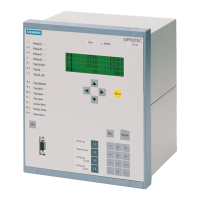Functions
2.11 Automatic Reclosure Function 79 (Optional)
SIPROTEC, 7SD80, Manual
E50417-G1140-C474-A1, Release date 09.2011
148
2.11.2 Setting Notes
If the automatic reclosing function is not required, it can be set to Disabled at address 133. All parameters
for the settings of the automatic reclosing function are thus not accessible.
To use the internal automatic reclosing function, the type of reclosing must be specified at address 133 79
Auto Recl. and the AR control mode at address 134 when configuring the device scope of functions
(section 2.1.1.2).
The 7SD80 allows up to 2 reclosing attempts with the integrated automatic reclosing function. Whereas the set-
tings in address 3401 to 3425 apply commonly to all reclosing cycles, the individual settings of the two cycles
are entered from address 3450 onwards.
The automatic reclosing function can be turned ON or OFF under address 3401 FCT 79.
A prerequisite for automatic reclosing taking place after a trip due to a short circuit is that the circuit breaker is
ready for at least one OPEN-CLOSE-OPEN cycle at the time the automatic reclose circuit is started, i.e. at the
time of the first trip command. The readiness of the circuit breaker is signaled to the device via the binary input
„>Bkr1 Ready“ (no. 371). If no such signal is available, leave the setting under address 3402 52? 1.TRIP
= NO because no automatic reclosing would be possible at all otherwise. If circuit-breaker interrogation is pos-
sible, you should set 52? 1.TRIP = YES.
Furthermore the circuit-breaker ready state can also be interrogated prior to every reclosure. This is set when
setting the individual reclose cycles (see below).
To check the ready status of the circuit breaker is regained during the dead times, you can set a circuit-breaker
ready monitor time under address 3409 CB TIME OUT. The time is set slightly longer than the recovery time
of the circuit breaker after a TRIP–CLOSE–TRIP–cycle. If the circuit breaker is not ready again by the time this
timer expires, no reclosure takes place, the automatic reclosure function is blocked dynamically.
Waiting for the circuit breaker to be ready again can lead to an increase of the dead times. To avoid uncon-
trolled prolongation, it is possible to set a maximum prolongation of the dead time, in this case in address 3411
Max. DEAD EXT.. This prolongation is unlimited if the setting ∞ is applied. This parameter can only be set in
DIGSI at Display Additional Settings. Remember that longer dead times are only permissible after 3-pole trip-
ping when no stability problems occur.
The restraint time T-RECLAIM (address
3403) is the time after which the fault is considered eliminated follow-
ing successful
reclosing. Re-tripping by a protective function within this time initiates the next reclose cycle in
the event of multiple reclosure; if no further reclosure is permitted, the last reclosure is treated as unsuccessful.
The restraint time must therefore be longer than the longest response time of a protective function which can
start the automatic reclosing circuit.
A few seconds are generally sufficient. In areas with frequent thunderstorms or storms, a shorter blocking time
may be necessary to avoid feeder lockout due to sequential lightning strikes or cable flashovers.
A longer restraint time should be chosen where circuit-breaker supervision is not possible (see above) during
multiple reclosing attempts, e.g. because of missing auxiliary contacts and information on the circuit-breaker
ready status. In this case, the restraint time should be longer than the time required for the circuit-breaker
mechanism to be ready.
The blocking duration following manual close detection BLOCK MC Dur. (address 3404) must guarantee the
circuit breaker to open and close reliably (0.5 s to 1 s). If a fault is detected by a protection function within this
time after closing of the circuit breaker was detected, no reclosure takes place and a final trip command is
issued. If this is not desired, set address 3404 to 0.

